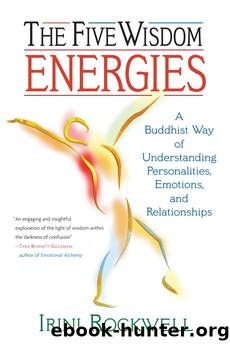The Five Wisdom Energies by Irini Rockwell

Author:Irini Rockwell
Language: eng
Format: epub
Publisher: Shambhala
When one person has finished, switch roles. Then talk with each other about this process or bring your answers back to the group.
After the exercise you might feel that the negative aspects of the relationship have not been dealt with. Trust the exercise and ride the sense of positive outlook that has been created. When you focus on the positive, you see your sanity clearly, and neurosis falls away. If issues remain, you could do another session of appreciative inquiry around them later.
11
Living in the Mandala
Four hundred of us were living together that spring in a quaint old hotel, all studying Buddhism and practicing meditation. This was overwhelming for the hotel switchboard operator, more accustomed to handling guests who did not know one another. Come the cocktail hour, she was inundated as never before with calls from one room to the next. And she made mistakes, connecting this room to this rather than this room to that. She soon realized that it didnât seem to matter whom she plugged into whom. We all seemed to have something to say to one another!
This is an illustration of mandala principleâthe inherent interconnectedness of the five energies. In essence a mandala is an energetic field encompassing the totality, the big picture. A mandala is a map: the flatlands of spacious energy, the peaks of intellect, the lush valleys of abundance, and so forth. The map is also moving, like a weather map on TV. Connecting to the mandala provides a sense of universality, a larger vision and greater perspective. It could be the mandala of our family or the weather or our body or our workplace. In Tibetan Buddhist art, mandalas depict whole cosmologies resplendent with iconographic detail. The four cardinal directions are sometimes represented by deities in the vajra, ratna, padma, and karma families, while in the middle of the mandala is a deity representing the spaciousness of buddha-family energy.
Whereas the solid, concrete world creates boundaries, the energetic world creates connections. The perspective of mandala is less egocentric than our ordinary perspective because we are not the constant reference point. Visualizing ourselves as the center of our own mandala requires recognizing that we are multifaceted and many-dimensional. The mandala puts our perspective in a larger context. It liberates us from our little way of perceiving things. Seeing the big picture takes a big mind.
INTERCONNECTEDNESS AND TOTALITY
The totality of mandala perspective has to do with our inner psychological world as well as the outer phenomenal world. The landscape of thoughts and emotions is our inner mandala; the external world is the outer mandala. There is a constant play between the two. In any given moment they are informing each other.
Our sense perceptions form a bridge between the inner and outer mandalas. They are our antennae, feeding data from the outer environment to our inner world of thoughts and emotions. How we see the world depends on our internal reality. (More on sense perceptions in chapter 14.) For instance, when I first moved to Nova Scotia, wow, how I hated the weather.
Download
This site does not store any files on its server. We only index and link to content provided by other sites. Please contact the content providers to delete copyright contents if any and email us, we'll remove relevant links or contents immediately.
The Way of Zen by Alan W. Watts(5843)
Ego Is the Enemy by Ryan Holiday(4042)
The Art of Happiness by The Dalai Lama(3419)
The Book of Joy by Dalai Lama(3274)
Why Buddhism is True by Robert Wright(2862)
Shift into Freedom by Loch Kelly(2713)
Spark Joy by Marie Kondo(2703)
Happiness by Matthieu Ricard(2549)
A Monk's Guide to a Clean House and Mind by Shoukei Matsumoto(2423)
The Lost Art of Good Conversation by Sakyong Mipham(2142)
The Meaning of the Library by unknow(2090)
The Third Eye by T. Lobsang Rampa(1900)
The Unfettered Mind: Writings from a Zen Master to a Master Swordsman by Takuan Soho(1881)
Anthology by T J(1771)
Red Shambhala by Andrei Znamenski(1766)
The Diamond Cutter by Geshe Michael Roach(1685)
Thoughts Without A Thinker: Psychotherapy from a Buddhist Perspective by Epstein Mark(1608)
Advice Not Given by Mark Epstein(1533)
Twilight of Idols and Anti-Christ by Friedrich Nietzsche(1511)
